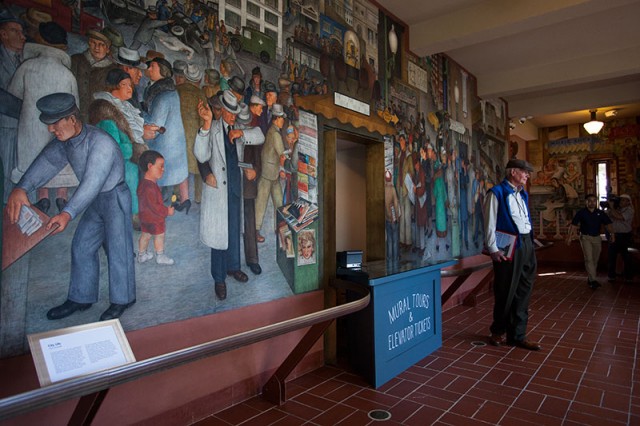
Coit Tower, the iconic monolith punctuating Telegraph Hill, reopened today after a six-month renovation. During the closure, workers restored the tower's historic murals and made structural improvements to the 81-year-old landmark. San Francisco Recreation & Parks waived the normal elevator fee ($5 for residents and $7 for out-of-towners) for the day, inviting visitors to take in the 360-degree views from the top of the tower. Several politicians, including Supervisor David Chiu and Mayor Ed Lee, were on hand for a ceremonial ribbon-cutting, which took place under the stifling midday sun. "These are historic landmarks in the city; they mean something to generations of people, and we have the privilege of reintroducing them to kids and generations of our own," said Lee.

The view from the top of the tower is what draws crowds up to Telegraph Hill, but the murals covering the tower's first- and second-floor walls are also a big attraction. The first floor is open to the public, and the second floor can be viewed by private tour only. In all, 19 artists and 26 assistants produced the murals — many of which are frescos — through the New Deal's Public Works of Art Project. The influences of prominent early 20th century Mexican muralists, such as Diego Rivera, can be seen in the tower's 27 historic murals. They depict heavy industry, labor and chaotic street life of Depression-era California — a stark contrast to the quiet streets surrounding Coit Tower today. At least one mural, which contained communist symbolism, was removed before the tower opened in 1933. "The significance of [the murals] is that they depict California industrial and agricultural life of the time," said volunteer docent Val Hendrickson. "Within the murals you can see fomenting labor unrest and the effects of the Depression."

The murals were in pretty good shape prior to the restoration, according to Allison Cummings from the San Francisco Arts Commission, but some of them had been scratched, and several suffered water damage. Tower renovations, which coincided with the art restoration, should prevent future water damage from occurring. During the mural restoration, all of the frescoes were cleaned, making them look much brighter. Workers also did restoration work on the ceilings and the stucco borders around the murals. The total budget for fixing up the murals was about $450,000, which enabled a team of four restorationists to work on the project for about six weeks. "There are no scratches, there are no white areas on the murals, and it looks as it did when it was painted 80 years ago," said Cummings.

The murals weren't the only thing to get a face-lift during the six-month renovation. A new gift shop was added; the elevator was updated; restrooms were upgraded; the roof was replaced; brass railings to protect the murals were adjusted; doors were updated; and handrails were added outside. Workers installed scaffolding around the exterior of the tower, and they used binoculars in order to identify cracks, according to Toks Ajike, a project manager for S.F. Rec & Parks. Those cracks are what enabled water to infiltrate the building over time. "It's an old, delicate structure, and over time historic structures require a level of care," said Ajike.

Fixing up historic structures is never quite as simple as it appears, and the renovation team ended up doing a little more work than was originally planned. The paint on the ceiling of the gallery was failing, and it contained hazardous materials, like asbestos and lead. That required workers to do some abatement before it could be replastered and repainted. Those unforeseen challenges, combined with some new features, such as dramatic new exterior lighting, caused the renovation budget to climb from $1.1 million to about $1.6 million. New colored LED lights will be programmed and ready to use within the next few weeks, said project manager Matt Jasmin.
